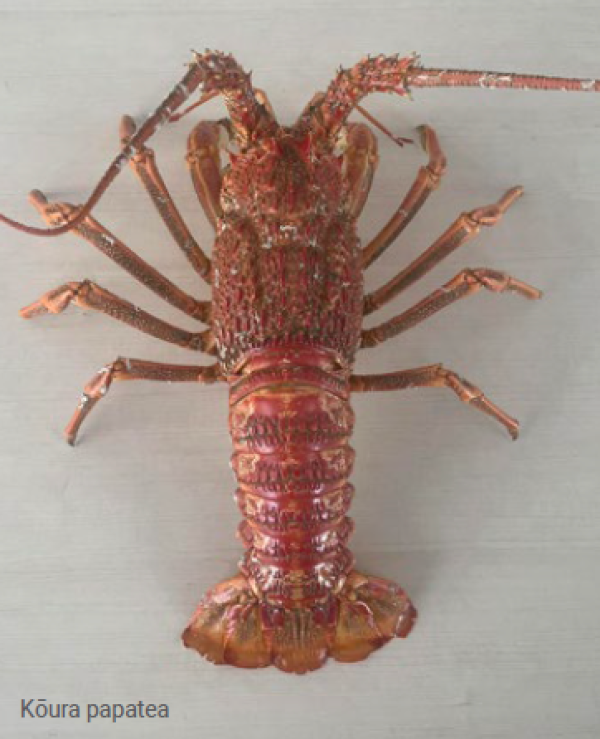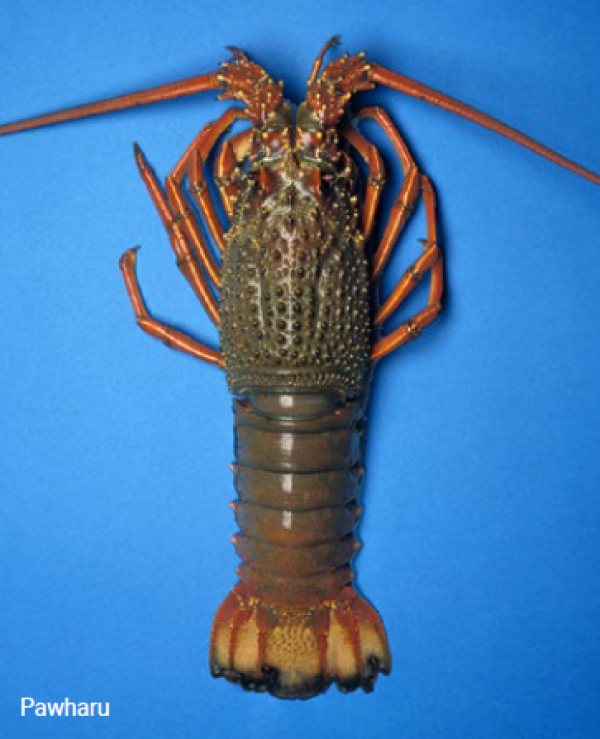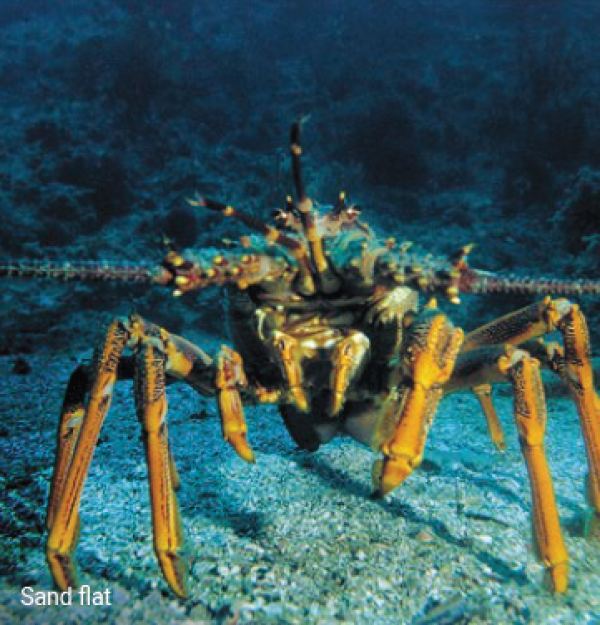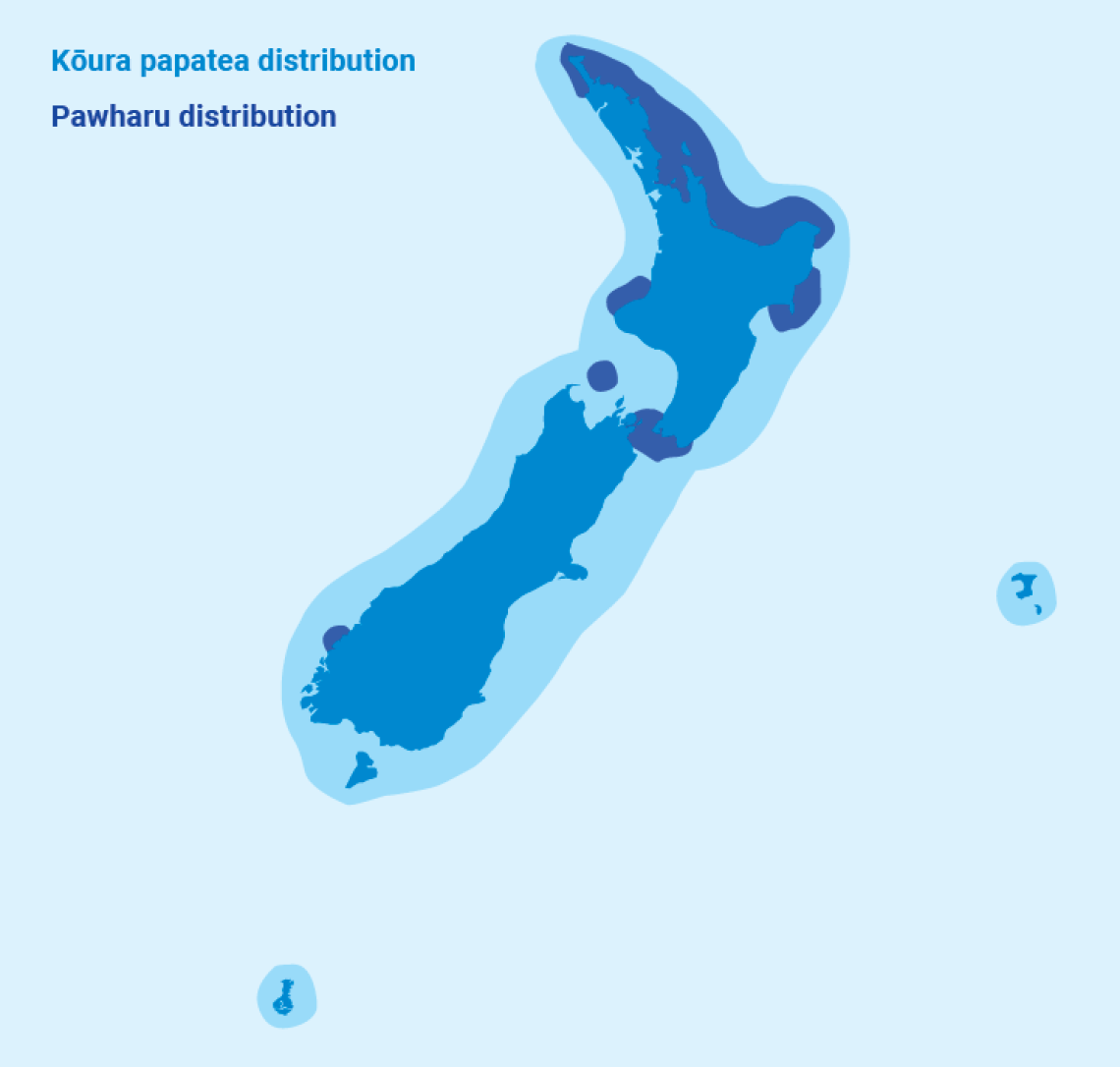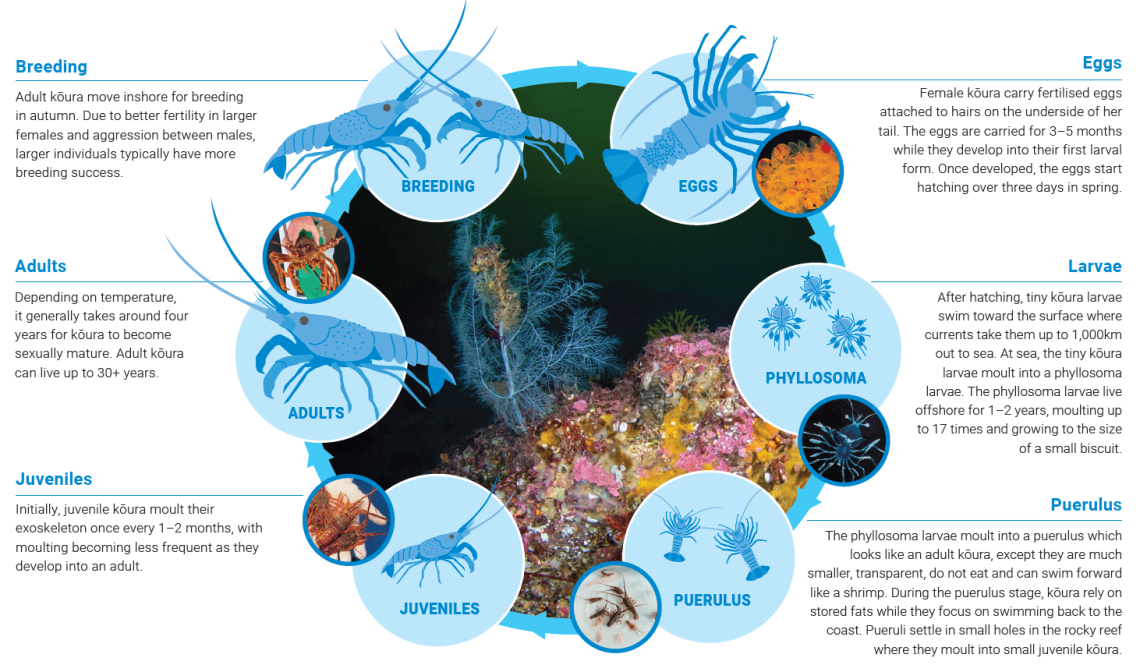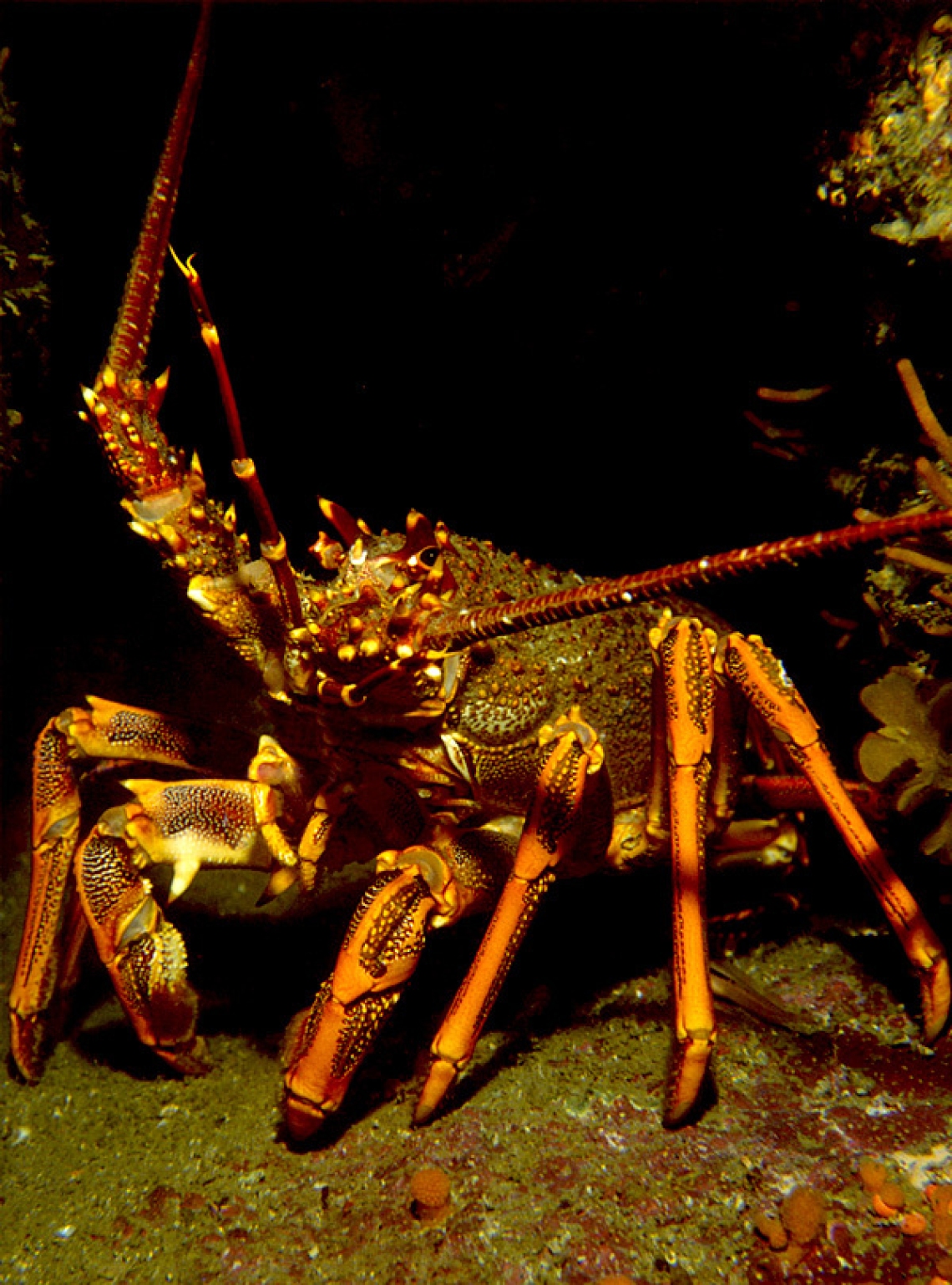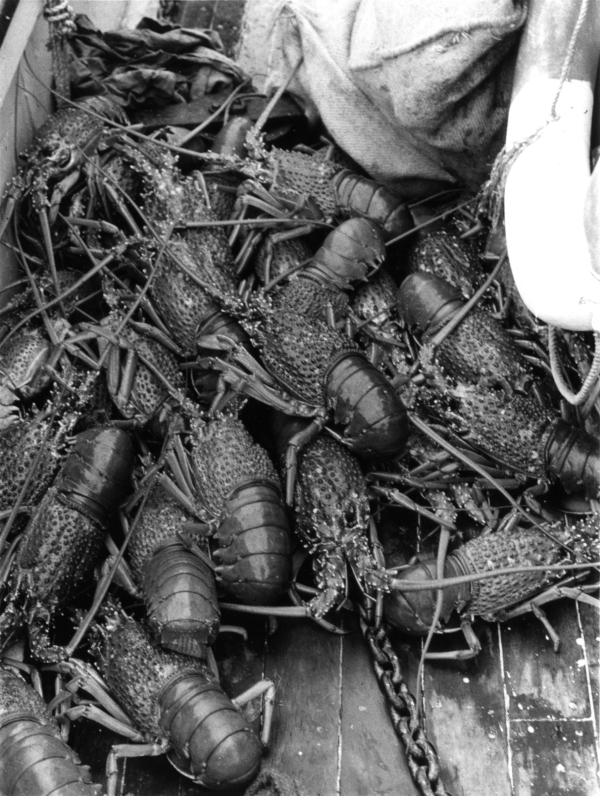On this page
Click button below to view other species in series
Kōura Species
Kōura are decapod crustaceans, more closely related to slipper lobsters than to freshwater kōura. Two species are found in our coastal waters, both of which are endemic to Aotearoa and Australia.
Kōura papatea
Kōura matapara / red rock lobster
Jasus edwardsii
Kōura papatea are reddish orange in shallower water and more reddish purple in deeper water. The tail surface is spiny and appears much more textured than the pawharu. Kōura papatea can grow to a generous size, and has been measured at 54 cm in length and up to 8 kg in weight.
Pawharu
Packhorse lobster
Sagmariasus verreauxi
Pawharu can be identified by the olive-green colour (brighter green in small individuals, to dull brown-green in larger individuals). Compared to the kōura papatea, the tail surface of pawharu is much more smooth in appearance and to the touch. Pawharu can grow to around 60 cm in length and 15 kg in weight.
Where do kōura live?
The kōura papatea and pawharu are found in coastal waters around the mainland and offshore islands up to 220-250m depth.
Kōura papatea live on rocky reefs and adjacent sand flats, and in most areas keep within a roughly 5kmstretch of coastline during their lifetime. Kōura also undergo seasonal inshore-offshore movement creating groups on sandflats, gravel and rocky substrates. These migrations are related to moulting, reproduction and food gathering.
Did you know?
Although smaller on average, kōura papatea are more aggressive and dominant over pawharu when competing for food.
Distribution
Kōura papatea
Found from Rangiputa in the north to the Auckland Islands in the south, and to the Chatham Islands in the east at the depths from 1 m to 250 m where suitable rocky outcrops occur.
Pawharu
Mainly occurs from East cape to the far north on rocky reefs and adjacent sandy areas at depths from 1 m to 100+.
Life Cycle
Kōura have one of the longest and most complex lifecycles of any kaimoana species.
Kōura anatomy
Rostrum
Protects the eyes and aids in general stabilisation.
Eye
Compound eyes to visually aid in detecting predators, prey and their environment.
Abdomen
Hard outer shell protecting a large muscle. The shell is divided into 6 layered segments that allow bending of the abdomen which is used for swimming propulsion.
Uropods
Makes up the outer segments of the fan-like tail, used for swimming.
Telson
Is the centre segment of the fan-like tail, used for swimming.
Antennule
Multi-sensory organ detecting chemical, physical and many other environmental changes (temperature, oxygen, etc.).
Walking legs
10 walking legs used for climbing over substrates. In females, the last pair of walking legs has a forked claw.
Pleopods
Projections from the underside of the abdomen are primarily used for swimming, sometimes referred to as swimmerets.
Males have single paired pleopods per segment (also used in mating), whilst females have two pairs per segment (also used to brood eggs).
Is this kōura male or female?
Click to find out!
Single pleopods characteristics of a male kōura.
Click to find out!
Side view of double pleopods holding eggs on a female kōura.
Learn more about identifying sex of kōura
Female kōura are identifiable by the small hooks at the tip of each of the rear walking legs which are used to groom their eggs.
Sex can also be determined by the number of pleopods on the underside of the tail - females have two sets of pleopods per segment, males have one set per segment.
In general, pawharu can grow to a larger maximum size than the kōura paptea.
Did you know?
Tail fan necrosis is a bacterial infection that has been found in New Zealand rock lobsters since 2000. This causes the uropods and telson to become blistered and black and can result in the loss of limbs.
What do kōura eat?
Kōura are opportunistic feeders that actively forage at night, emerging from their daytime shelters to find slow-moving prey.
Their diet consists of shellfish, kina and starfish, but they won't pass up the opportunity if other slow-moving food crosses their path, such as worms and even bait! Kōura have strong mandibles or jaws that can crush thick shells such as the tuangi, or cockle!

Did you know?
Kōura and snapper are some of the only known predators of the long-spined kina, which are becoming increasingly more abundant in parts of the North Island.
How do kōura behave?
As kōura grow, they forage further and further from their daytime shelter. Newly settled juveniles keep foraging within a few metres of their shelter, while three-year-old juveniles forage up to 20 metres or so.
Some behaviours observed in kōura are unique to certain areas. For example, around the southern part of the South Island, larger juvenile kōura migrate south to Stewart Island then north and west toward Fiordland, and sometimes even further north to Milford Sound. This migratory behaviour hasn’t been seen in juvenile kōura around the rest of Aotearoa, possibly because they reach sexual maturity at a smaller size than those in the far south.
When kōura reach maturity most of their life is spent within a 3–5kmstretch of coast. Adult kōura make short seasonal movements inshore to moult and mate, and offshore to feed.
What are the threats to kōura?
Fishing pressures directly affect population density, size, age structure and male-female ratios.
When the population structures (density, size, age) are altered, effects such as decreased reproduction rates,
emigration and reduced/increased size at maturity can occur. Overfishing on kōura populations can lead to low
population numbers which reduces the role kōura play in the ecosystem.
Kōura also face habitat degradation through increased ocean temperatures which cause physiological stress and oxygen availability. Kina barrens also reduce the settlement of juveniles.
How can we help kōura?
If gathering kōura, it is important to identify the species and follow the crayfish rules and guidelines:
Some kōura are protected, these include:
• Undersized kōura
• Kōura ‘in berry’ (females carrying eggs under the tail). Female papatea are in berry March - October and pawharu October - February – be aware or cautious if collecting during these months.
• Kōura in the soft-shell stage (during moult)
• Kōura that can’t be measured (due to tail damage for
example).
Some restrictions to harvesting kōura apply, these
include:
• Kōura may not be brought to the surface if they are unmeasurable
• Harvesting is restricted to hand operated loops or lassos (no spring-loaded tools)
• Tools which can puncture the shell, such as spears, are prohibited
• Eggs and egg-bearing appendages cannot be removed from a kōura.
Note: Regulations as at April 2024

